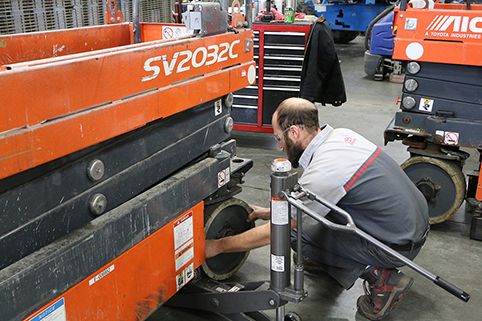Boost Your Solution: Choosing Lift Maintenance Services and Repair Companies Near Me
Boost Your Solution: Choosing Lift Maintenance Services and Repair Companies Near Me
Blog Article
Comprehensive Overview to Elevator Solutions and Their Maintenance
Navigating the intricate globe of elevator systems and their upkeep is a task that demands precision and knowledge. From the different kinds of elevator systems in use to the precise adherence to safety policies, the upkeep of these vertical transportation devices is a complex endeavor.
Sorts Of Elevator Solutions
Lift systems come in numerous kinds, each created to suit certain structure demands and user requirements. The most common types consist of hydraulic elevators, grip lifts, machine-room-less elevators, and vacuum cleaner lifts. Hydraulic elevators are ideal for low-rise structures and use a hydraulic piston to move the lift cars and truck. Grip elevators, on the various other hand, are much more suited for high-rise structures and use steel ropes and weights to relocate the automobile. Machine-room-less lifts are a space-saving alternative as they do not require a separate machine space for the elevator machinery. Vacuum cleaner lifts, a much more modern development, use atmospheric pressure differentials to move the vehicle within a transparent tube.
Each sort of elevator system has its very own benefits and drawbacks, making it important for structure owners and programmers to meticulously consider their details needs before selecting the most ideal option. Aspects such as constructing height, space accessibility, power effectiveness, and spending plan restraints all play a considerable function in identifying the very best elevator system for a particular structure.
Common Maintenance Problems
Routine upkeep of elevator systems is necessary to make sure smooth operation and prolong their life-span. Regardless of normal upkeep, lift systems can still run into common upkeep issues that need to be quickly addressed to stop disturbances in solution. Among one of the most regular concerns is door breakdowns. Lift doors may get misaligned, resulting in concerns with opening and closing correctly. This can trigger hold-ups and safety threats, needing immediate focus from maintenance professionals. An additional typical trouble is connected to the elevator's leveling accuracy. Passengers might experience tripping dangers and pain if the lift does not line up properly with the floors. Furthermore, issues with the control system, such as sensing unit issues or electric problems, can cause the lift to malfunction or quit functioning altogether. Normal examinations and aggressive upkeep can aid identify and resolve these usual maintenance concerns prior to they rise and impact the overall efficiency of the elevator system.
Safety Regulations and Conformity
Complying with rigorous safety and security policies and making certain conformity with market requirements are extremely important for preserving the functional integrity of elevator systems. Elevators are subject to a detailed set of security regulations to safeguard guests, maintenance employees, and the general public. Regulatory bodies such as the Occupational Safety and Health And Wellness Administration (OSHA) in the USA and the European Lift Organization (ELA) in Europe establish guidelines that cover numerous elements of lift layout, upkeep, installation, and procedure.
Conformity with these regulations is not only a legal requirement however likewise an ethical obligation for building proprietors and elevator upkeep business. Failing to click here to read satisfy safety standards can result in penalties, legal liabilities, and, most notably, endanger the safety and security of individuals utilizing the lift. Regular examinations, maintenance checks, and adherence to security procedures described in the guidelines are necessary to make sure the efficient and secure operation of elevator systems. By focusing on safety laws and compliance, stakeholders can promote the trust fund of the public and mitigate potential threats linked with lift usage.
Best Practices for Upkeep

Building owners need to also consider spending in innovation upgrades to improve the performance and security of their elevator systems. By adhering to these ideal techniques, elevator systems can operate smoothly and safely, offering reliable vertical transportation for residents.

Advanced Technologies for Effectiveness
Executing advanced technologies in lift systems can significantly boost operational effectiveness and passenger experience. These systems enable travelers to input their preferred floor prior to getting in the lift, which then guides them to the most reliable auto.
Furthermore, the integration of smart sensing units and anticipating maintenance abilities has actually revolutionized elevator maintenance. These sensing units can spot prospective concerns before they rise, allowing aggressive maintenance interventions and lessening downtime. Furthermore, making use of regenerative drives and energy-efficient elements helps decrease power consumption and operating expense in elevator systems.
In addition, published here the application of cloud-based surveillance and remote diagnostics allows for real-time tracking of elevator efficiency and immediate troubleshooting of any type of malfunctions. This proactive method not only boosts system dependability however likewise enhances the overall customer experience by ensuring smooth and undisturbed elevator procedures.
Conclusion
In verdict, comprehending the various kinds of elevator systems, common maintenance concerns, security policies, finest maintenance techniques, and progressed modern technologies for performance is crucial for ensuring the smooth operation of lifts. By adhering to security policies and executing finest methods for maintenance, structure owners can extend the lifespan of their elevator systems and make sure the safety of passengers. It is crucial to remain upgraded on the most up to date advancements in elevator technology to boost effectiveness and dependability.
The most common types include hydraulic elevators, grip elevators, machine-room-less elevators, and vacuum cleaner lifts. Hydraulic lifts are excellent for low-rise buildings and make use of a hydraulic piston to move the elevator automobile. Machine-room-less elevators are a space-saving option as they do not need a different equipment space for the lift machinery. Normal examinations and proactive upkeep can aid identify and deal with these common upkeep concerns before they intensify and influence the total performance of the elevator system.

Report this page